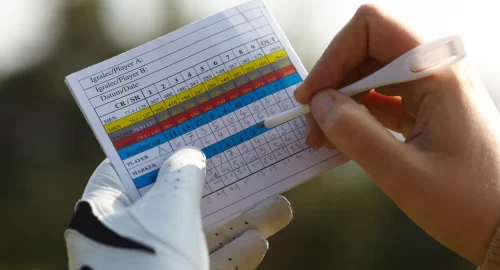
Reading golf greens is more of an art than anything else. It takes some time to get this process down; learn what matters and how to translate what you read into your putting stroke.
To help you improve your green reading skills, we’ve compiled a list of basic tips and concepts to keep in mind next time you’re on the course. Keep in mind, that with many aspects of golf, practice and experience will keep you improving over time.
So, what is reading the green? The green is commonly referred to as the putting area at the end of a golf hole, where the grass is shortest and you use your putter to get the ball in the hole. Reading the green is the act of assessing the angles of the green, so you can best direct your putt.
11 Tips For Better Green Reading
We recommend you start with working on one or two of these tips at a time. In golf, it makes sense to figure out which concept works for you and then stick with it. There will be some trial and error involved, but once you get better at reading greens, you can take the skill with you to any new course you go to.
1. Start Reading As You Approach The Green
As you are approaching the golf green, you should already be reading it. You may not know exactly what your putt is going to do just yet, but you can get a picture of the overall slope and the way that the green is built from a distance.
Some greens are sloped front to back or back to front. Others will have the left or right side considerably lower than the other. Do yourself a favor and take note as you walk towards the green, instead of just when you’re standing directly on it. This will make it easier for you to read it as well.
Green reading can change on a daily basis depending on the way they were cut and rolled that day.
2. Check For Grain
Some greens are very grainy, so it’s important to be able to detect this aspect of the green. Think of the phrase “going against the grain” here. If you’re hitting into or against the grain, your putt will naturally move slower and vice versa.
When looking at the green with the sun shining, the shiny and brighter side will be down or “with the grain,” while the darker side will be against the grain. Alternatively, you can walk up to the cup and look for how the grass is flowing around the hole.
Typically, one side of the hole will be wilted; the wilted side shows you the grain. You can also determine the grain by feeling the green; down-grain putts are always smoother, whereas putts into the grain naturally have a bit more traction and resistance.
3. Always Read From More Than One Angle
Read the green from more than one angle. Don’t stand behind your ball and think that you’ve seen everything you need to see. Make sure to take a complete loop around the golf ball and analyze what the green looks like from the other side.
Only half the story is being told when you look at the green from behind the ball and not the other side.
Make this green reading process part of your pre-putt routine.
4. Analyze How the Wind Can Impact Your Read
When choosing a club off the tee box or for your approach shot, you are likely well aware of the wind direction, and how it could affect your shot. It’s important to realize that while slightly less strong, wind will also impact putts.
Especially when playing on coastal courses or areas with high wind speeds, expect putting into the wind to be a little slower. If you go uphill and into the wind, you will need a little more strength in the putt.
In addition, the break may be a little less on these types of putts, encouraging you to go straight for the hole instead of reading too much into it.

5. Don’t Give Away The Hole More Than You Should
One of the biggest mistakes that amateur golfers make is reading too much into a putt.
On the shorter putts around the hole, it is often best to aim to the left side or right side of the cup and use just a little extra speed in your stroke. If you expect these putts to break a ton, you could end up missing the hole because you read too much into it.
Remember that a golf ball breaking a few inches takes quite a bit of slope. On a three-foot to six-foot putt, don’t give the hole away too much unless the slope warrants it.
6. Determine How Speed Plays Into Your Read
Speed and green reading go hand in hand.
A 15-foot putt with three inches of break (the amount a putt moves from right to left, or left to right, on a green) can be made in a variety of ways depending on the speed that you use.
The best suggestion here is to find a putting speed that you are comfortable with. Some golfers like a little extra ball speed and a little less break; others find that playing more into the break and putting with a little less speed is a better match for their game.
The key here is to keep the speed as consistent as you can throughout your round. If you like to read a lot of break into a putt, that is fine, but do it from the first hole through to the 18th hole.
If you don’t, you bring too much inconsistency into your game.
7. Learn From Your Time On The Course
By the time you get to the 3rd or 4th hole, you’ve made more than a handful of putts and have probably seen a variety of angles and distances, certainly enough to learn from.
Green reading can change on a daily basis depending on the way they were cut and rolled that day. Pay close attention to what you have learned on the previous holes and how that can play into the rest of your round, even if you’ve played on that course many times before.
You will hear many amateur golfers talking about how they just can’t get the greens down today. Try not to use this as an excuse; start learning from the time you take your first putt, and put that knowledge into action.
8. Use A Yardage Book or App
Yardage books and green reading apps will help you understand how slope influences your green reading.
Sometimes, being able to make those mathematical connections between what you are seeing and how much slope actually exists is all that you need to become better at green reading.
Yardage books and apps are great for highly analytical and detail-oriented golfers. If you are more of a feel player, stick to visualization and learning through practice.
9. Trust Your Instincts
You can spend quite a bit of time on a green; reading it and determining which way the ball is going to move. However, if your instincts tell you that it’s a little further left or a little further right than it shows, trust your gut.
Why?
When you trust what you are doing and have confidence in the stroke you are about to make, your chances of the ball going in the hole are much greater. You’ll learn more about yourself and your golf instincts this way too.
10. Don’t Forget Shadows and the Sun
The sun angle can often play tricks on you when it comes to green reading. Areas with heavy shadows from the sun look as though there is very little break.
Be careful with this concept though, and spend some time walking around the entire hole to ensure you are both seeing and feeling how much slope there is.
11. Imagine Water Flow and Drainage
Finally, this green reading tip works quite well for new golfers. If you really can’t determine what your golf ball is going to do, try to visualize the way water would flow.
Thinking about the movement of water is sometimes easier than thinking about a single golf ball rolling toward the hole.
Use these visualization strategies to improve your green reading and overall comfort when looking at the putt you have in front of you.
Do You Need To Work On Green Reading or Putting Stroke?
If you want some more insight from Performance Golf professionals on mastering your putting game, check out this YouTube video!
When working on your putting game, it can sometimes be hard to decide if it’s your green reading or your putting stroke that is not quite right. Here are a few things to look for that will tell you if its your green reading that could use some improvement, not necessarily your putt stroke.
- Consistently misreading the hole despite making a good putting stroke means you may need to work on your green reading skills.
- Not understanding grain or slope, and the overall impact both have on the direction of the golf ball.
- If you only make a putt after watching a playing partner make the putt, it’s probably time to learn to read greens for yourself.
- Continually being surprised by the direction your golf ball takes after putting it is a sign you need to work on your green reading.
- Working on putting mechanics and related issues and seeing no improvement is a sign that your green reading could use some work.
If you want some more insight from Performance Golf professionals on mastering your putting game, check out this YouTube video!
Final Thoughts on Reading the Green
Green reading is a skill that you will get better at over time. In the meantime, capitalize on these tips for better green reading. Remember that golf is a game in nature, so try putting yourself in that mindset when it comes to the grass, wind and sun.
Spend some time on the greens, trust your instincts, and try not worry so much about your putting stroke. The green read and the putt go hand in hand, and you’ll master it over time.

